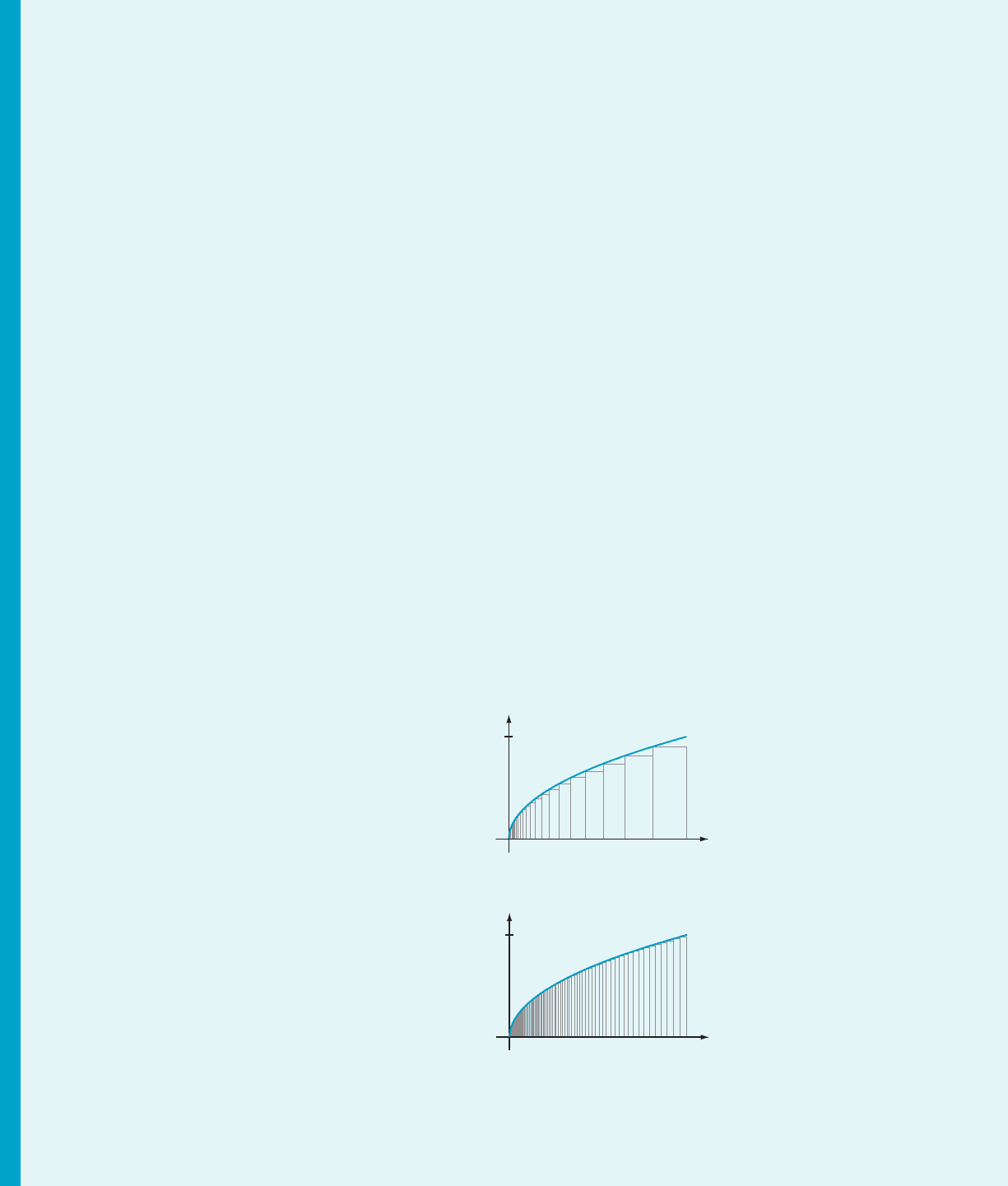Blank B.E., Krantz S.G. Calculus: Single Variable
Подождите немного. Документ загружается.


GENESIS
&
DEVELOPMENT5
Archimedes
The Greek geometer Eudoxus (ca. 408ca. 355 BCE)
used the limiting process to rigorously demonstrate area
and volume formulas that Democritus (ca. 460ca. 370
BCE) had discovered earlier. The arguments that
Eudoxus introduced came to be known as the Method of
Exhaustion. In the hands of Archimedes, this method
became a powerful technique.
In one of his earliest works, Archimedes derived a
formula for the area of a parabolic sector. An arc
_
AVB
of a parabola is drawn in Figure 1. The point V is
known as the vertex of the segment and is character-
ized as follows: Among all line segments from the chord
AB to the parabolic arc
_
AB that are perpendicular to
chord
AB, the one terminating at V is longest. Archi-
medes demonstrated that the area A enclosed by
line segment
AB and parabolic arc
_
AVB is 2hb/3, or
(4/3) 3 jΔAVBj (using the notation |R|todenotethe
area of a planar region R). The introduction of V creates
two parabolic subarcs,
_
AV and
_
VB.Eachhasavertex;
these vertices are labelled V1andV2inFigure2a.
Archimedes proved from a few easily derived geometric
properties of the parabola that
jΔAV
1
Vj1 jΔVV
2
Bj5
1
4
jΔAVBj:
At the next iteration, illustrated in Figure 2b, Archi-
medes interposed four new vertices V
3
, V
4
, V
5
,andV
6
and concluded that
jΔAV
3
V
1
j1 jΔV
1
V
4
Vj5 j
1
4
ΔAV
1
Vj and
jΔVV
5
V
2
j1 jΔV
2
V
6
Bj5
1
4
jΔVV
2
Bj:
Combining these two equalities yields
7ΔAV
3
V
1
7 1 7ΔV
1
V
4
V7 1 7ΔVV
5
V
2
7 1 7Δ V
2
V
6
B7
5
1
4
ð7ΔAV
1
V7 1 7ΔVV
2
B7Þ5
1
4
2
7ΔAVB7:
Continuing, Archimedes “exhaust ed” the pa rabolic
segment by a sequence {R
n
} of regions composed of
triangles: R
0
5 ΔAVB; R
1
5 ΔAV
1
V,ΔVV
2
B; R
2
5
ΔAV
3
V
1
,ΔV
1
V
4
V,ΔVV
5
V
2
,ΔV
2
V
6
B; R
3
,....In
general, |R
n
| 5 4
n
|R
0
|. Using the formula for the sum
of a geometric progression, Archimedes obtained
jR
1
,R
2
,,R
N
j5
11
1
4
1
1
4
2
1 1
1
4
N
3 jΔAVBj
5
4
3
1
1
4
N11
jΔAVBj:
He finished this proof with an airtight argument
that 1=4
N11
-0andA5 4jΔAVBj=3.
The Method
The translation of Archimedes’ works into Latin in the
late 1500s introduced European mathematicians to the
power of the infinite process. Although these mathe-
maticians found elegant formulas, rigorous proofs, and
glimpses of what might be attained, they did not find
the methods by which Archimedes discovered his
results. The 17th-century mathematician John Wallis
even protested that Archimedes “covered up the traces
of his investigations, as if he has grudged posterity the
secret of his method of inquiry.” So the matter stood
for 200 more years.
V
A
B
b
h
m Figure 1 Archimedes proved that the
area of the parabolic segment AVB is
equal to (2/3) hb
V
V
1
V
2
A
B
m Figure 2a Vertex V creates two
parabolic segments with vertices V1
and V2.
V
V
1
V
6
V
5
V
4
V
2
V
3
A
B
m Figure 2b Repeat the process of
adding vertices.
465

In 1906, Danish scholar Johan Ludvig Heiberg
learned of a manuscript that had be en catalogued in a
cloister in Constantinople (now Istanbul). The manu-
script contained a religious text of the Eastern
Orthodox Church and was a so-called palimpsest —a
parchment of which the original script had been washed
and overwritten. Because it was reported that the ori-
ginal mathematical text had been imperfectly washed,
Heiberg voyaged from Copenhagen to Constantino ple
to investigate. What Heiberg uncovered was a mathe-
matical manuscript containing numerous works of
Archimedes. It had been copied in Greek in the 10th
century only to be washed and written over in the 13th
century. As luck would have it, most of the original text
could be restored.
Heiberg’s chief find was the Method Concerning
Mechanical Theorems, dedicated to Eratosthenes.
Scholars had known from the references of later Greek
mathematicians that such a work had existed until at
least the 4th century
CE but, until Heiberg’s discovery,
the text was presumed to be lost. In the Method, we
find, to use the words of Wallis, Archimedes writing for
posterity:
Archimedes to Eratosthenes, Greeting: . . . since I
see that you are an excellent scholar . . . and lover of
mathematical research, I have deemed it well to
explain to you and put down in this same book, a
special method whereby the possibility will be
offered to you to investigate any mathematical
question by means of mechanics . . . . [I]f one has
previously gotten a conception of the problem by
this method, it is easier to produce the proof than to
find it without a provisional conception. . . . [W]e
feel obliged to make the method known partly . . . in
the conviction that there will be instituted thereby a
matter of no slight utility in mathematics.
Theory of Indivisibles
The first half of the 17th century saw a number of
attempts to use infinite processes in the computation of
areas, volumes, and center s of gravity. Among the most
important of the early contributors were Pierre de
Fermat and Gilles Rober val in France, Bonaventura
Cavalieri and Evangelista Torricelli in Italy, and John
Wallis and Isaac Barrow in England. In 1635, Cavalieri
introduced his Theory of Indivisibles, a relatively
effective albeit cumbersome procedure for calculating
areas and volumes. Using his method, Cavalieri
became the first to show that
R
1
0
x
n
dx 5 1=ðn 1 1Þ for
natural numbers n. Although Cavalieri’s student
Evangelista Torricelli became the foremost proponent
of the Theory of Indivisibles, Torricelli believed that
Cavalieri had only rediscovered a method that Archi-
medes must have known:
I should not dare confirm that this geomet ry of
indivisibles is actually a new discovery. I should
rather believe that the ancient geometers availed
themselves of this method in order to discover the
more difficult theorems, alt hough in their demon-
stration they may have preferred another way, either
to conceal the secret of their art or to afford no
occasion for criticism by invidious detractors.
Fermat and the Integral Calculus
The extension of Cavalieri’s formula
R
1
0
x
n
dx 5
1=ðn 1 1 Þ from natural numbers to rational values of n
was obtained independently by Fermat and Torricelli.
Fermat’s clever demonstration runs as follows: Given
natural numbers p and q 6¼0, let f (x) 5 x
p/q
. Fix a
number r 2(0, 1), and set x
k
5 r
kq
for k 5 0,1,2,....The
points {x
k
} serve to (nonuniformly) partition [0, 1] into
infinitely many subin tervals. Fermat’s idea was to use the
sum
P
N
k5 0
f ðx
k
Þðx
k
x
k11
Þ to approximate the area
under y 5 x
p/q
for 0 # x # 1. Figure 3a shows the
approximation for r 5 0.9. By taking a larger value of r
(with r still less than 1), we obtain a better approximation
(see Figure 3b). In the limit, we obtain the exact area:
1
y x
p/q
r 0.98
x
0
x
1
x
2
x
3
m Figure 3b
1
y x
p/q
r 0.9
x
0
x
3
x
2
x
1
m Figure 3a
466 Chapter
5 The Integral

Z
1
0
f ðxÞdx 5 lim
r-1
lim
N-N
X
N
k5 0
f ðx
k
Þðx
k
x
k11
Þ:
For f (x) 5 x
p/q
, we calculate
Z
1
0
x
p=q
dx 5 lim
r-1
lim
N-N
X
N
k5 0
ðr
kq
Þ
p=q
ðr
kq
r
ðk11Þq
Þ
5 lim
r-1
lim
N-N
X
N
k5 0
r
kp
r
kq
ð1 r
q
Þ
5 lim
r-1
ð1 r
q
Þ lim
N-N
X
N
k5 0
r
ðp1qÞk
:
Because 0 , r
p 1 q
, 1, we may apply formula (2.5.3)
to obtain
Z
1
0
x
p=q
dx 5 lim
r-1
1 r
q
1 r
p1q
:
Although we know how to compute the inde-
terminate form on the right by using l’Ho
ˆ
pital’s Rule,
Fermat had to resort to the following tricky backward
application of formu la (2.5.2):
Z
1
0
x
p=q
dx 5 lim
r-1
1 r
q
1 r
p1q
5 lim
r-1
ð1 r
q
Þ=ð1 rÞ
ð1 r
p1q
Þ=ð1 rÞ
5
lim
r-1
2
P
q1
k5 0
r
k
lim
r-1
2
P
p1q1
k5 0
r
k
5
q
p 1 q
5
1
p=q 1 1
:
Kepler and Roberval
Before the discovery of the Fundamental Theorem of
Calculus, many mathematicians succeeded in evaluat-
ing particular integrals by ad hoc methods. For exam-
ple, in his last great astronomical work, the Epitome
Astronomiae Copernicanae (16181621), Kepler cal-
culated what we would now call a limit of Riemann
sums for
R
β
0
sinðtÞdt. In effect, Kepler discovered the
formula
Z
β
0
sinðtÞdt 5 1 cosðβÞ:
One curve that attracted the attention of promi-
nent mathematicians throughout the 17th century was
the cycloid, which is the locus of points generated by a
fixed point on a circle as the circle rolls along a line at
constant speed without spinning or slipping (see Figure
4). Early in the 17th century, Galileo conjectured that
the area under one arch of the cycloid is three times the
area of the rolling circle. To reach this conjecture, this
leading scientist resorted to cut-out paper figures. By
1636, Roberval was able to rigorously verify Galileo’s
conjecture. Roberval’s work is a measure of how much
progress had been made in a very short period of time.
Newton and the Fundamental Theorem of
Calculus
Sir Isaac Newton’s first contact with higher mat he-
matics came as a college senior in 1664 when he was 21
years old. He learned the tangent problem from the
G
´
eom
´
etrie of Descartes, and he learned Cavalieri’s
Theory of Indivisibles from Wallis’s Arithmetica Infi-
nitorum. It was Wallis’s work that, in the winter of
16641665, led Newton, who was still an under-
graduate, to evaluate the area of the region unde r the
graph of y 5 (1 2 t
2
)
α
and over the t-interval [0, x]. In
doing so, he had already taken the decisive step of
letting the endpoint of integration be a variable, a key
idea of the Fundamental Theorem of Calcul us.
When plague closed Cambridge University in 1665
and 1666, Newton returned home to reorganize his
discoveries. He wrote his discoveries in “The October
1666 Tract on Fluxi ons,” a manuscript that was not
published until 1967. It was in this tract that Newton
first stated both parts of the Fundamental Theorem of
Calculus. This remarkable manuscript also contains
several other theorems, including the Chain Rule and
Integration by Substitution.
Notation
The notation that we use today for the indefinite inte-
gral was introduced by Gottfried Wilhelm Leibniz
(16461716) in a manuscript of 1675. At that time,
Leibniz did not include the differential. For example,
he wrote
R
x
2
5 x
3
=3. By the time his work appeared in
print in 1686, however, Leibniz included the differ-
ential in his notation and stressed its importance. The
modern notation
R
b
a
f ðxÞdx for the definite integral—
that is, the positioning of the limits of integration on the
integral sign—was introduced in 1822 by Joseph
Genesis & Development 467
m Figure 4 A point on a rolling
circle generates a cycloid.

Fourier (17681830). It was Fourier’s work that indir-
ectly led to the Riemann integral. Fourier’s study of
heat transfer required the evaluation of definite inte-
grals of the form
R
2π
0
f ðxÞsinðnxÞdx for quite general
functions f. However, the definition of integration then
in use was far too limited for the desir ed generality.
Georg Friedrich Bernhard Riemann (18261866) rea-
lized that, to further develop Fourier’s work, a new
concept of the integral was needed. Toward that end, in
1854, Riemann introduced what we now call the Rie-
mann integral.
Bernhard Riemann
Riemann’s short life was marked by nervous break -
downs and serious illness—pleurisy, jaundice, and,
ultimately, tuberculosis. Although he began his studies
in theology, he was able to convince his father to allow
him to pursue what was then an “economically value-
less” subject—mathematical physics. In quantity, his
mathematical output was relatively modest for a
mathematician of his stature. Yet his work has assumed
fundamental importance in several fields— he is
remembered for the Riemann inte gral in analysis, the
Riemann zeta function in number theory, Riemann
surfaces and Cauchy-Riemann eq uations in the theory
of functions of a complex variable, and Riemannian
manifolds in geomet ry. The importance that his work
has had in physics is also noteworthy. Indeed, Rie-
mannian geometry proved to be essential for Einstein’s
theory of relativity, as well as for much of the physics
that has been done since.
468 Chapter 5 The Integral

CHAPTER 6
Techniques
of Integration
The purpose of the present chapter is to develop some facility with calculating
integrals. Until now, the integrals that we have calculated have been of two types.
Either we have immediately recognized an antiderivative, or we have converted an
integral into one of that type by making a direct substitution. In fact, an array of
diverse procedures can be brought to bear on the calculation of integral s. In this
chapter, we will study the most important of those methods.
Tables of integrals a nd computer algebra systems are valuable resources for
calculating integrals. However, neither renders obsolete the need for a basic
working knowledge of integration theory. In this section, you will learn funda-
mental algebraic and trigonometric mani pulations that are the basis for evaluating
integrals that arise frequently in mathematical applications. But the methods you
will learn in this section have a significance that transcends integration theory.
Indeed, these techniques are needed for the development of many important topics
in engineering, science, and mathematics.
PREVIEW
469

6.1 Integration by Parts
The integral of the sum of two functions is the sum of their integrals. This simple
observation enables us to break up some complicated integration problems into
several simple ones. But what if we want to integrate the product of two functions?
A technique called integration by parts enables us to evaluate many integrals that
involve a product of two functions.
The Product Rule
in Reverse
If u and v are two differentiable functions, then we know that
d
dx
ðu vÞ5
du
dx
v 1
dv
dx
u:
We rewrite this equation as
u
dv
dx
5
d
dx
ðu vÞ2 v
du
dx
:
Integrating both sides gives
Z
u
dv
dx
dx 5
Z
d
dx
ðu vÞdx 2
Z
v
du
dx
dx
Observing that u v is the antiderivative of
d
dx
ðu vÞ, we obtain the integration by
parts formula:
Z
u
dv
dx
dx 5 u v 2
Z
v
du
dx
dx: ð6:1:1Þ
INSIGHT
Often we use “differential notation” and summarize the integration by
parts formula as
Z
udv5 uv 2
Z
vdu: ð6:1:2Þ
Here dv is shorthand for
dv
dx
dx,anddu is shorthand for
du
dx
dx. This compact form of
the integration by parts formula is the easiest to remember. Bear in mind, however, that it
conceals the original variable of integration (x in our discussion).
We may use a version of formula (6.1.2) for definite integrals provided that we use
appropriate limits of integration:
Z
x5b
x5a
udv5 u v
x5b
x5a
2
Z
x5b
x5a
vdu: ð6:1:3Þ
Some Examples ⁄ EXAMPLE 1 Calculate
R
xcosðxÞdx:
Solution We
integrate by parts. Our first job is to decide what function will play
the role of u an d what function will play the role of v. Let us take u 5 x and
dv 5
dv
dx
dx 5 cos ðxÞdx : Then
R
x cosðxÞdx 5
R
udv: Therefore according to
equation (6.1.2),
Z
xcosðxÞdx 5 uv 2
Z
vd
u: ð6:1:4Þ
Our task is to work out the right-hand side. We already know what u is. What is v?
Because dv 5 cos(x) dx, we see that v 5
R
dv 5
R
cosðxÞdx is an antiderivative of cos(x).
470 Chapter 6 Techniques of Integration

Therefore we may take v 5 sin(x). Likewise, because u 5 x,itfollowsthat
du 5
du
dx
dx 5 1 dx: If we substitute for u, v,anddu on the right side of equation
(6.1.4), then we obtain
Z
x cosðxÞdx 5 x sinðxÞ2
Z
sinðxÞ1dx:
We have converted our original integration problem into a much easier one.
Because
R
sinðxÞdx 52cosðxÞ1 C; we conclude that
Z
x cosðxÞdx 5 x sinðxÞ2 ð2cosðxÞ1 CÞ5 xsinðxÞ1 cosðxÞ2 C:
If you prefer, you may replace the arbitrary constant C with 2C. Then, the answer
takes on the more familiar form x sin(x) 1 cos(x) 1 C.
As usual with indefinite
integrals, we can check our work by differentiating our answer and verifying that
the result equals the integrand:
d
dx
xsinðxÞ1 cosðxÞ2 C
5
xcosðxÞ1 sinðxÞ
1
2sinðxÞ
2 0 5 x cosðxÞ: ¥
INSIGHT
The purpose of integration by parts is to convert a difficult integral into a
new integral that will be easier. We must bear this notion in mind as we make our choice
of u and v. In Example 1, if we had selected u 5 cos(x) and dv 5 xdx, then we would
calculate du 5
du
dx
dx 52sinðxÞdx; v 5
Z
dv 5
Z
xdx5 x
2
=2, and the new integral
Z
vdu52
Z
x
2
2
sinðxÞdx
would have been harder, not easier, than the one we started with.
When a power of x is present in the integrand, it is often a good rule to choose u to
be the power of x. Then, when integration by parts is applied, the power of x will be
decreased. In this way, we guarantee in advance that one factor becomes simpler.
Of course, we must also consider the role of dv. As the next example shows, that
consideration may be more significant.
⁄ EXAMPLE 2 Calculate
R
4
1
2x ln(x) dx.
Solution In
this example, it would be foolish to take dv 5 ln(x) dx because we do not
know an antiderivative for ln(x). So we take dv 5 2xdxand u 5 ln(x). Then we have
u 5 lnðxÞ dv 5 2xd
x
du 5 ð1=xÞdx v 5 x
2
:
Thus
Z
4
1
2x lnðxÞdx 5
Z
4
1
lnðxÞ2xdx5
Z
4
1
udv5 uv
4
1
2
Z
4
1
vdu5 lnðxÞx
2
4
1
2
Z
4
1
x
2
1
x
dx:
Once again, we have converted a difficult integral into a new integral that is much
simpler. We continue calculating:
Z
4
1
2x lnðxÞdx 5 x
2
lnðxÞ
4
1
2
Z
4
1
x
2
1
x
dx 5
4
2
lnð4Þ2 1
2
0
2
8 2
1
2
5 16 lnð4Þ2
15
2
5 32 lnð2Þ2
15
2
: ¥
6.1 Integration by Parts 471

⁄ EXAMPLE 3 Calculate
R
lnðxÞdx
Solution This
is a new type of problem for us. On the one hand, we do not know an
antiderivative for ln(x). On the other hand, the integrand does not appear to be a
product because we see only the one function, ln(x). However, we can rewrite the
integral as
Z
lnðxÞ1dx:
We
take u 5 ln(x)anddv 5 1 dx. We have
u 5 lnðxÞ dv 5 1dx
du 5 ð1=x Þ dx v 5 x:
Thus
Z
lnðxÞ1dx 5
Z
udv5 u v 2
Z
vdu5 lnðxÞx 2
Z
x
1
x
dx
5 x lnðxÞ2
Z
1dx 5 x lnðxÞ2 x 1 C: ¥
Advanced Examples Sometimes applying integration by parts just once is not sufficient to solve the
problem at hand, and further applications might be needed. The next two exampl es
will illustrate.
⁄ EX
AMPLE 4 In atomic measurements, it is sometime s convenient to use
the Bohr radius α
0
5 0.52917725 3 10
210
m as a unit of distance. Let ρ denote any
(unitless) positive number. At a given instant of time, the probability of finding the
hydrogen electron at a distance no greater than ρ α
0
from the atomic nucleus is
Z
ρ
0
4r
2
e
22r
dr:
What is the probability p that the hydrogen electron is less than twice the Bohr
radius from the nucleus?
Solution The
answer is given by
p 5
Z
2
0
4r
2
e
22r
dr 5 4
Z
2
0
r
2
e
22r
dr 5 4 J where J 5
Z
2
0
r
2
e
22r
dr:
To calculate this integral, we take u 5 r
2
and dv 5 e
22r
dr. Then
u 5 r
2
dv 5 e
22r
dr
du 5 2rdr v 52e
22r
=2:
We therefore have
J 5
Z
2
0
r
2
e
22r
dr 5
Z
r52
r50
udv5 u v
r52
r50
2
Z
r52
r50
vdu
5 r
2
2
e
22r
2
r52
r50
2
Z
2
0
2
e
22r
2
2rdr 522e
24
1
Z
2
0
re
22r
dr:
Thus J 5 K 2 2e
24
where K 5
R
2
0
re
22r
dr: We see that our new integral K is simpler
than the one we started with (because the power of r is lower), but it still requires
472 Chapter 6 Techniques of Integration

work. Another application of integration by parts is needed. We apply the inte-
gration by parts formu la to K, taking u 5 r and dv 5 e
22r
dr We now have
u 5 rdv5 e
22r
dr
du 5 1dr v 52e
22r
=2:
Therefore
K 5
Z
2
0
re
22r
dr 5
Z
r52
r50
udv5 u v
r52
r50
2
Z
r52
r50
vdu
5 r
e
22r
22
r52
r50
2
Z
2
0
e
22r
22
dr 52e
24
1
1
2
Z
2
0
e
22r
dr
52e
24
1
1
2
e
22r
22
r52
r50
52e
24
1
1
2
e
24
22
2
1
2
1
22
5
1
4
2
5
4
e
24
:
Finally, the required probability p is given by
p 5 4J 5 4ðK 2 2e
24
Þ5 4
1
4
2
5
4
e
24
2 2e
24
5 1 2 13e
24
0:7618967: ¥
INSIGHT
If we organize our work properly, keeping repeated applications of the
integration by parts formula separate, then there is no harm in reusing the symbols u and
v each time. Also notice that we can use the integration by parts formula with a variable
of integration other than x.
In our next example, it will appear that we have evaluated an integral indir-
ectly. After integrating by parts, the original integral arises on the right side of the
equation with a coefficient not equal to 1. We treat the original integral as an
unknown variable, isolate it on one side of the equation, and divide the equation by
its coefficient.
⁄ EX
AMPLE 5 Calculate the integral
S 5
Z
e
x
cosðxÞdx:
Solution We
take u 5 e
x
and dv 5 cos( x ) dx. Then
u 5 e
x
dv 5 cos ðxÞdx
du 5 e
x
dx v 5 sinðxÞ:
Therefore
S 5
Z
udv5 u v 2
Z
vdu 5 e
x
sinðxÞ2
Z
sinðxÞe
x
dx:
6.1 Integration by Parts 473

We have converted the original integral problem S to a new integration problem,
but the new one does not look any simpler than the original—indeed, all we have
done is to replace cos(x) with sin(x). Nevertheless, we integrate by parts again,
taking u 5 e
x
and dv 5 sin(x) dx. As a result,
u 5 e
x
dv 5 sinðxÞdx
du 5 e
x
dx v 52cosðxÞ:
We have
S 5 e
x
sinðxÞ2
Z
sinðxÞe
x
dx 5 e
x
sinðxÞ2
2e
x
cosðxÞ1
Z
cosðxÞe
x
dx
:
Using the symbol S, we can rewrite this last equation as
S 5 e
x
sinðxÞ1 e
x
cosðxÞ2 S:
We can solve this equation for S, obtaining
S 5
1
2
e
x
sinðxÞ1 e
x
cosðxÞ
:
Finally, let us observe that, because S is an indefinite integral, a constant of inte -
gration should be added to obtain the most general solution:
S 5
1
2
e
x
sinðxÞ1 cosðxÞ
1 C: ¥
INSIGHT
The integral that we have just calculated arises naturally in signal pro-
cessing and may be found in many engineering texts. A remarkable feature of the method
of Example 5 is that we never “calculate” the integral in the usual way. We express the
integral (which we think of as the unknown S) in terms of itself, and then we obtain
the solution by using algebra.
The method of Example 5 can also be applied to integrals of expressions of
the form sin(ax) cos(bx), sin(ax) sin(bx), and cos(ax) cos(bx). Because these
integrals are sometimes needed in applications, we will record them for reference
(not for memorization):
Z
sinðaxÞcosðbxÞdx 52
1
2
cosðða 2 bÞxÞ
a 2 b
2
1
2
cosðða 1 bÞ x Þ
a 1 b
1 C; a 6¼ 6b ð6:1:5Þ
Z
sinðaxÞsinðbxÞdx 5
1
2
sinðða 2 bÞ x Þ
a 2 b
2
1
2
sinðða 1 bÞxÞ
a 1 b
1 C; a 6¼ 6b ð6: 1 :6Þ
Z
cosðaxÞcosðbxÞdx 5
1
2
sinðða 2 b ÞxÞ
a 2 b
1
1
2
sinðða 1 bÞ x Þ
a 1 b
1 C; a 6¼ 6b: ð6:1: 7 Þ
In our next example, we must appeal to a trigonometric identity before we can
apply the method of Example 5.
474 Chapter 6 Techniques of Integration
